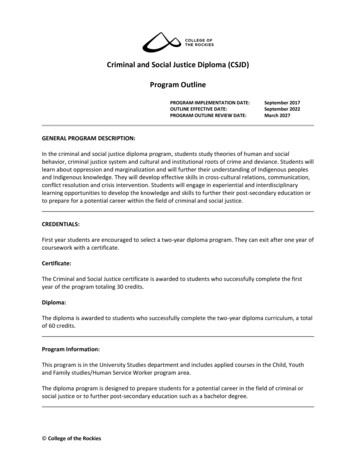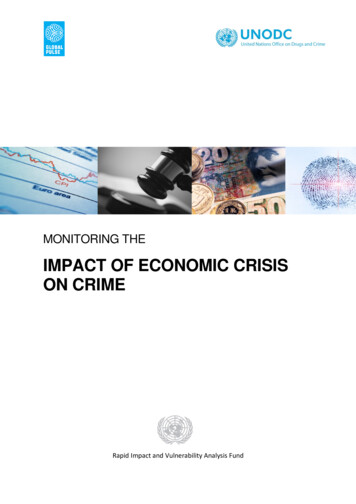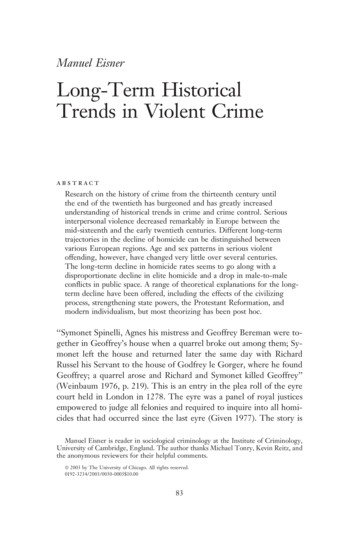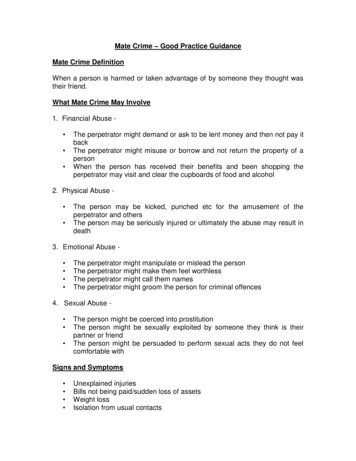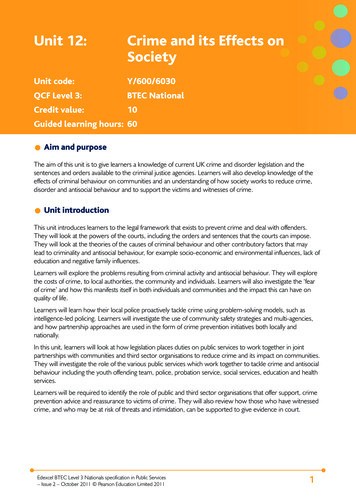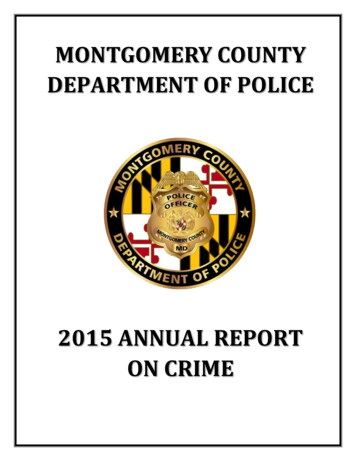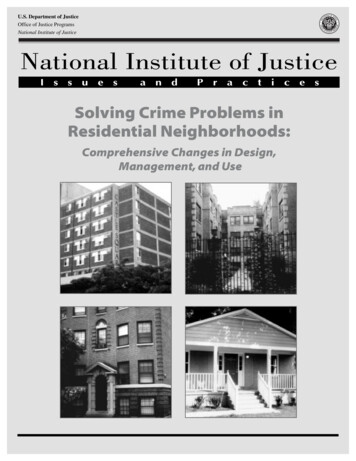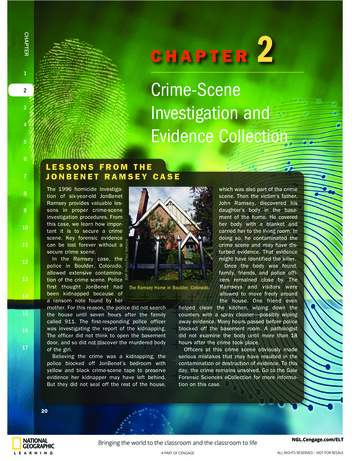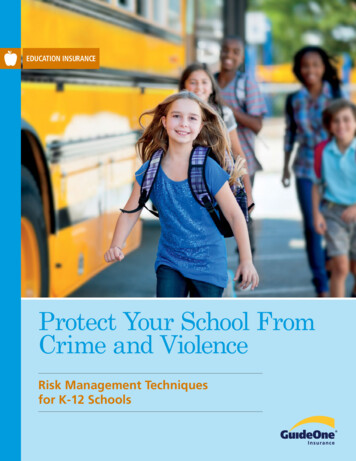
Transcription
EDUCATION INSURANCEProtect Your School FromCrime and ViolenceRisk Management Techniquesfor K-12 Schools
Your Safetyis Our PriorityThis material is for information onlyand is not intended to provide legalor professional advice. You areencouraged to consult with your ownattorney or other expert consultantsfor a professional opinion specific toyour situation. This information is onlya general description of the availablecoverages and is not a contract. In aneffort to keep your policy coverageaffordable, the actual policy containscertain limitations and exclusion.Please refer to your insurance policyfor the pertinent contract languageand coverages. Some coverages anddiscounts are not available in all states.L ike us on Facebook:facebook.com/GuideOneF ollow us on Twitter:twitter.com/GuideOneThank you for taking the first step toward a safereducational institution. In this guide, you willfind helpful tips, practical advice and real-worldexamples you can use to continue building yourschool’s safety program.The material you will find here is based on nearly50 years of safety inspections and claims servicefor thousands of organizations across the country.This guide represents just one area of a K-12school’s overall safety plan. Any reliable riskmanagement program should also include acomprehensive insurance package. GuideOneproudly offers coverage for private and charterschools to help reduce the risk of loss and liability.Our goal is to keep your resources focused onyour educational mission. We believe your timeis better spent interacting with students thandealing with losses and legal issues. To learnmore about the various types of schools we insureand the coverages we offer visit, GuideOne.com/insurance/education or call 1-877-448-4331.
ContentsK-12 School Violence. 413 Habits of Safe Schools. 6Ways to Ramp Up Building Security . 8External Threat Deterrence. 9Team Up With Your Local Law Enforcement . 10Identifying the Warning Signs of Violence . 11Early Warning Signs . 11Imminent Warning Signs. 12Incident Planning and Response. 13What Can You Do?. 15Students. 15Parents. 16Resources. 17 2017 GuideOne Center for Risk Management, LLC. All rights reserved.This material is for information only and is not intended to provide legal or professional advice. You areencouraged to consult with your own attorney or other expert consultants for a professional opinion specificto your situation.31111 Ashworth Road West Des Moines, Iowa 50265 1-877-448-4331 www.GuideOne.com
K-12 School ViolenceReports of K-12 school violence are on the rise. It seems a week seldom goes by that we don’t hear aboutviolence on a school campus. From the middle school student in South Carolina who brought a gun to aneighboring elementary school and shot a first grader to the Utah high school student who was disarmedon campus by his parents when they discovered a family gun missing, the stories are worrisome.Active shooter incidents in the United States continue to rise infrequency, with new FBI statistics showing the highest average ofincidents ever in a two-year period. Schools have frequently beenlocations for shootings. The possibility of someone bringing a weapononto your campus is troublesome. However, there are a number ofthings your school can do to protect against school violence.School violence is any violence that occurs on school property or during a school-sponsored event.Students and adults (including staff and guests) can be victims, perpetrators or witnesses.AVERAGE # OF ACTIVE SHOOTER INCIDENTSIN TWO-YEAR PERIODYOUTH RISK BEHAVIOR SURVEILLANCE SYSTEM (YRBSS)2013 - CENTER FOR DISEASE CONTROL AND PREVENTIONPercentage of High School Students Threatened orInjured with a Weapon1 on School 014-20156.95Total7.7Female6.1Male1. For example, a gun,knife, or club2. One or more timesduring the 12 monthsbefore the survey0source file: ABC NEWSNational Youth Risk Behavior Survey Overview: Statistics available iew.htmSchool violence includes various behaviors. Some violent acts, such as bullying, pushing, and shoving, cancause more emotional harm than physical harm. Other forms of violence, such as gang violence and assault(with or without weapons), can lead to serious injury or even death.41111 Ashworth Road West Des Moines, Iowa 50265 1-877-448-4331 www.GuideOne.com
IN A 2015 NATIONAL STUDY OF HIGH SCHOOL STUDENTS (KANN L, 2015):887.8% reported being in a physical fight on school property in the 12 months preceding the survey.8810.3% of male students and 5.0% of female students reported being in a physical fight on schoolproperty in the 12 months preceding the survey.885.6% did not go to school on one or more days in the 30 days preceding the survey because they feltunsafe at school or on their way to or from school.884.1% reported carrying a weapon (gun, knife or club) on school property on one or more days in the30 days preceding the survey.886.0% reported being threatened or injured with a weapon (gun, knife or club) on school property oneor more times in the 12 months preceding the survey.Kann L, McManus T, Harris WA, et al. Youth Risk Behavior Surveillance – United States, 2015. MMWR Morb Mortal Surveil Summ.2016;65(SS-06):1-174. Available from .pdfHowever, there are many ways in which your school can reduce the risk of suchincidents occurring. The following pages provide strategies you can take to create a safer school insideand out, along with tips for strengthening your partnership with students, parents and law enforcement.51111 Ashworth Road West Des Moines, Iowa 50265 1-877-448-4331 www.GuideOne.com
13 Habits of Safe SchoolsThe schools with the best chance at reducing violence are the ones that offer supportive, solution-drivenenvironments with open communication channels. Here’s how they achieve that – and how your schoolcan, too.1. Focus on academic achievement. Effective schools appreciate students’ individual differences andconvey the attitude that all children can achieve academically and behave appropriately. Expectationsmust be communicated clearly, with the understanding that meeting such expectations is a responsibilityof the student, the school and the home. Students who do not receive this support are less likely tobehave in socially desirable ways.2. Involve families in meaningful ways. Students whose families are involved in their growth inand outside the classroom are more likely to succeed in school and less likely to engage in antisocialactivities. Effective schools also support families in expressing concerns about their children and supportfamilies in getting the help they need to address behaviors that cause concern. There should be effectivetwo-way communication between the school and the family regarding behavioral issues – both sidesneed to be free to express concerns and information that could help.3. Develop links to the community. Schools that have close ties to families, support services,community police, the faith-based community and the community at large can benefit from manyvaluable resources. When these links are weak, the risk of school violence is heightened.4. Emphasize positive relationships among students and staff. Research shows that a positiverelationship between students and adults who are available to provide support when needed is oneof the most critical factors in reducing student violence. Students often look to adults in the schoolcommunity for guidance, support and direction. Make sure that opportunities exist for staff to spendquality, personal time with students.5. Discuss safety issues openly. You can reduce the risk of violence at your school by teachingchildren about the dangers of firearms and by sharing appropriate strategies for dealing with feelings,expressing anger in appropriate ways and resolving conflicts. Teach children that they are responsible fortheir own actions.6. Treat students with equal respect. A major source of conflict is the perceived or real problemof bias and unfair treatment of students because of race, gender, etc., by both staff and peers. Studentswho have been treated unfairly may become targets of violence. In some cases, victims may react inaggressive ways. Effective schools communicate to students and the greater community that all childrenare valued and respected.7. Create ways for students to share their concerns. Peers are often the most likely group toknow in advance about potential school violence. That’s why it is important to implement ways forstudents to safely and discreetly report such troubling behaviors. In turn, students who report potentialschool violence must be protected.61111 Ashworth Road West Des Moines, Iowa 50265 1-877-448-4331 www.GuideOne.com
8. Help children feel safe when expressing their feelings. It is important that children feel safewhen expressing their needs, fears and anxieties to school officials. When children do not have access tocaring adults, feelings of isolation, rejection and disappointment are more likely to occur, increasing theprobability of acting-out behaviors.9. Develop a system for referring children who are suspected of being abused orneglected. The referral system must be appropriate and reflect federal and state guidelines.10. Offer extended day programs for children. School-based before- and after-school programscan be effective in reducing violence. Such programs should be well-supervised and provide childrenwith support and a range of activity options. The staff of these programs are often the most likelyto connect with troubled students and assist with behavioral interventions as they are not seen as ateacher or administrator.11. Promote good citizenship and character. Schools reinforce and promote the shared valuesof their local communities, such as honesty, kindness, responsibility and respect for others, and oneof the best ways to achieve this is to acknowledge that parents are the primary moral educators oftheir children and work in partnership with them.12. Identify problems and assess progress toward solutions. When you gather this information,share it with students, families and the community at large.13. Support students in making the transition to adult life and the workplace. Youthneed assistance in planning their futures and in developing skills that will result in success. If yourschool doesn’t already offer community service opportunities and work-study programs, look intooffering them. These opportunities help connect students with the adults in your community, andthe relationships they build foster a sense of hope and security for the future.71111 Ashworth Road West Des Moines, Iowa 50265 1-877-448-4331 www.GuideOne.com
Ways to Ramp Up Building SecurityProtecting against crime and violence starts with making sure your school is a safe and caring place.Effective and safe schools convey a strong sense of security. Experts suggest that you can enhancephysical safety with the following strategies:88Supervise access to the building and grounds. Request that all visitors check in at the officeand that they be escorted on campus. Visitors should not have unsupervised access to children.88Adjust scheduling. Minimize the amount of time in hallways where students have unsupervisedactivities.88Conduct a building safety audit. Work with school security or local law enforcement experts toidentify areas of campus that present security concerns.88Close school campuses during lunch periods. People with criminal intent use the access to schoolgrounds to conduct illegal and dangerous activities. Lunch time is a prime opportunity for others to accesscampus and for students to return to campus with contraband. Securing the campus reduces these risks.88Adopt a school policy on uniforms. Studies show that standardizing school dress codes minimizescomparisons between students. This can help in curtailing bullying.88Prohibit students from areas where they are likely to engage in rule-breaking.Students should not have access to cafeteria delivery areas, auditoriums, gymnasiums and other areaswhen not supervised.88Welcome an adult presence. Encourage parents to visit the school when appropriate. Groups ofadults on campus provide a visible deterrence to crime.88Stagger dismissal times and lunch periods. Minimize the number of students in the hallwayat any one time. Staggering times by grade level helps to minimize the risks of bullying, especially whenelementary and high school students may be on the same campus.88Maintain school grounds. “Crime Prevention Through Environmental Design” is the techniqueof minimizing risks by laying out buildings and landscaping in ways that provide maximum visibilityand deterrence. This can include trimming bushes, increasing lighting and directing traffic throughsupervised areas.81111 Ashworth Road West Des Moines, Iowa 50265 1-877-448-4331 www.GuideOne.com
External Threat DeterrenceUnfortunately many threats come from those with minimal or no connection to your school. They can comefrom a domestic dispute that makes its way to your campus, local gang activity or random acts. This typeof violence is particularly troubling in that it usually comes with very few warning signs. However, there arethings you can do to minimize the impact on your campus.The goal is to minimize access to your facilities and plan for an effective and timely response.88Limit access to your campus. This is the first step in trying to keep external threats off your campus.Having a fenced perimeter with signage requiring all visitors to sign in will make it more difficult for thosewith evil intent to have access to your students. In addition, all employees and contractors or vendorsshould wear some type of identification. It should be very clear to everyone on your campus if someoneis present who does not belong there. While your campus should be a comfortable place for students andstaff, uninvited guests should stick out and should immediately be directed to the office.88Identify and escort visitors. When visitors come to the office, they should be greeted and given atemporary identification that clearly states where on campus they should be going and with whom theyshould be meeting. A parent who is volunteering in a classroom does not need access to the gymnasium,PE locker rooms or utility closets. Vendors should be escorted when possible.88Allow only one open entrance point during school hours. Ideally, the campus should be laidout in such a way that the only open access during school hours would be through the school office. Ina perfect world, the cafeteria delivery area should be outside the fenced perimeter and should have noaccess to students.88Keep exterior doors locked at all times. Exterior doors (with the possible exception of thoseleading directly to the office) should be self-locking and should be kept locked. In addition, interior doorsto unoccupied rooms should remain locked as well. This deters both criminals and students who are notwhere they should be. All classroom doors should have the ability to be locked from the interior veryquickly. It may even be appropriate to keep these doors locked at all times.88Use video surveillance. Wherepossible, there should be videosurveillance of the entrances toyour campus. These views shouldbe monitored and recorded. Videocameras do not always captureeverything, but their presence showsthe public that you are committed tosafety and security on your campus.It’s all part of making uninvitedguests feel very uncomfortable.91111 Ashworth Road West Des Moines, Iowa 50265 1-877-448-4331 www.GuideOne.com
Team Up WithYour Local LawEnforcementEducators, police and juvenile authoritiesall play an integral part in reducing schoolcrime. The presence of police at or near theschool and local neighborhoods disruptstrouble spots that interfere with studentstraveling to and from school, preventsstrangers from entering schools, identifiesstudents who are selling drugs or are underthe influence of drugs, and more. Plus,routinely patrolling school grounds betterpositions law enforcement to act quicklywhen they receive a request for help fromschool authorities. Rapid response is criticalin a situation where many children are inharm’s way.88Establish a working relationship with your local police. Encourage your local law enforcementto visit your school. The worst time and place to meet your local authorities is over the hood of theirpatrol cars when they are responding to an incident. Build relationships early and work together onresponse plans.88Invite officers on campus and make them comfortable. Let officers know that they arewelcome to come in and use your restroom and grab a cup of coffee in between calls. Having an officersit in his or her patrol care while writing reports on school grounds is a great crime deterrent and buildsgood-will.88Offer your facilities for training opportunities. Law enforcement agencies are often lookingfor locations to host classroom lectures, active shooter drills and other training sessions. During summerand winter break downtime, your school might be the perfect location for them to continue to hone theirskills. What’s in it for you? Officers will learn the layout of your facility.88Hold a “Coffee with a Cop” or “Pizza with Police” event. This type of casual forum encouragesparents to meet the officers who patrol their children’s school. Officers can provide information onenforcement activities and response plans for the neighborhood and the school.88Invite officers to participate in school activities. Juvenile authorities and police both havespecialized training in working with youth and can become involved directly with students outside thepolice station, courtroom or other correctional setting. They often develop a good relationship withstudents as a means of preventing a confrontation in the future. As the relationship builds, students seepolice and juvenile authorities as positive role models – and this broad respect for authority is essential inreducing crime.101111 Ashworth Road West Des Moines, Iowa 50265 1-877-448-4331 www.GuideOne.com
Identifying the Warning Signs of ViolenceEarly Warning SignsWhen it comes to reducing violence from within your school’s community, the most valuablething you can do is to learn the early warning signs of a child who is troubled, so that youand others can provide effective intervention.Red Flags in an Elementary School Student88Has trouble paying attention and concentrating88Does poorly in school88Often disrupts classroom activities88Frequently gets into fights88Watches many violent TV shows and movies, and/or plays violent video games88Has few friends88Consistently does not listen to adults88Is cruel or violent towards pets or other animals88Is easily frustrated88Is not sensitive to the feelings of othersRed Flags in a Middle School or High School Student88Does not listen to authority figures88Pays no attention to the feelings or rights of others88Relies on physical violence or threats of violence to solve problems88Does poorly in school and often skips class88Misses school frequently88Gets suspended from or drops out of school88Joins a gang, gets involved in fighting and/or steals or destroys property88Drinks alcohol and/or uses inhalants or drugs111111 Ashworth Road West Des Moines, Iowa 50265 1-877-448-4331 www.GuideOne.com
If you pick up on any of these warning signs in a student, the next step is to rally staff around theremedying issue. Behavioral Intervention teams are groups of school staff whose goal is to identify studentswith behavioral and/or psychological issues and address these issues before harm is done to the student orothers. Typically this team will include the student’s teacher(s), counselor and administrators. In some cases,it may be appropriate to also get input from playground supervisors, bus drivers and others who interactwith the student on a regular basis. By comparing experiences and getting a more complete picture of theissue, it may be possible to provide a better Behavioral Intervention.Imminent Warning SignsUnlike early warning signs, which allow for intervention, imminent warning signs indicate that a studentis very close to behaving in a way that is potentially dangerous to him or herself and/or others. Imminentwarning signs include:88Serious physical fighting with peers or family88Severe destruction of property88Severe rage for minor reasons88Detailed threats of lethal violence88Possession and/or use of firearms and other weaponsThese behaviors require an IMMEDIATE RESPONSE. Safety must always be the first and foremostconsideration when warning signs indicate that danger is imminent. This is the time to bring in trainedprofessionals. In some cases, this may be the time to contact law enforcement.121111 Ashworth Road West Des Moines, Iowa 50265 1-877-448-4331 www.GuideOne.com
Incident Planning and ResponseEffective incident response is a result ofcareful planning. Every school shouldhave a violence response plan. This planshould be part of a larger emergencypreparedness plan and should includeat least the following:1. Security Assessments – Workwith your local authorities to surveyyour school grounds and look forspecific issues, such as dark parkinglots and unsupervised spacesbehind buildings which createopportunities for problems.2. Emergency Planning Team – A team of individuals from across the campus should be trainedin response procedures. Be sure to consider custodial, maintenance and food service staff as theyoften provide a broad understanding of the campus. This team will help develop the plan that allstaff will implement.3. Incident Plan (action steps during an incident)A. Call 911. Contact law enforcement immediately when faced with a potentially violentsituation. Most active shooter incidents are over in a matter of minutes. Get trained firstresponders on the way.B. Isolate the threat. Where possible, contain the individual who represents a threat bylocking doors and hallways.C. Protect students and staff. When it isn’t possible to safely evacuate students, keep themquietly grouped in the dark to minimize attention. Be sure to identify specific procedures forany special needs students.D. Follow first responder’s instructions. The law enforcement officers who are the firstto arrive on the scene don’t have time for a lengthy discussion. They are trained to confrontand “neutralize” the threat. They will not be stopping to help injured persons or assist withevacuation. Approach law enforcement slowly and in a non-threatening manner. Answerquestions quickly and clearly.4. Internal Communication Plan – How will you communicate a violent incident to your staff? Mostexperts agree that clear communication is best. Avoid the use of codes. Simply state what the issueis and give clear, concise instruction on how to respond. Methods of communication may include anintercom system, campus radios and/or a text messaging system.131111 Ashworth Road West Des Moines, Iowa 50265 1-877-448-4331 www.GuideOne.com
5. External Communications Plan – With whom do you need to communicate?A. Board members and administrators will need to be apprised of the situation.B. Parents will be concerned about their children and need instructions to be reunited withtheir student(s).C. Media may begin arriving shortly after first responders. You will need a location identifiedwhere they can set up and a person who will give updates.6. Training and Exercises – Plans are never fully implemented until those responsible can act out thoseplans based on muscle memory. In the same way that we have been trained to respond to a fire alarmby evacuating the building in an orderly fashion, students and staff should be trained in how to performa reverse evacuation.7. Post Incident Recovery – No response is perfect. There is always an opportunity to learn fromwhat went well and what did not go well.141111 Ashworth Road West Des Moines, Iowa 50265 1-877-448-4331 www.GuideOne.com
What Can You Do?School crime is made up of everyday occurrences and can be reduced through everyday actions. The actionsof students and parents help ensure a safer campus community. These ideas should be shared at studentassemblies and parent meetings as well as published in school newsletters and other communication.Students can Behave responsibly88Resolve problems and disputes non-violently88Refrain from teasing, name calling, and other seemingly innocent behaviors that actually hurtothers’ feelings88Respect other students88Know and follow the school rulesReport crimes and threats to school officials88Students know better than anyone else what is going on in their school88Reporting threats and crimes can protect students and sometimes even save livesGet involved in or start anti-crime programs88Students can directly reduce school crime by becoming peer counselors, serving as mediators,learning conflict resolution, etc.Avoid being a victim88Walk away from fights, avoid dangerous areas, decide who to associate withSeek help88Identify adults who they trust, because these adults often provide the necessary help andresources to resolve a troubling issue.151111 Ashworth Road West Des Moines, Iowa 50265 1-877-448-4331 www.GuideOne.com
Parents can Communicate with their children and be available and approachable88Consistency, honesty and understanding are criticalProvide clear and consistent discipline88Parental views on crime, violence, weapons and appropriate self-defense are necessary, andchildren need to know that parents support school discipline policiesModel pro-social behavior88One of the best ways to teach a child is by demonstration. Through everyday actions, parentsteach their children how to interact socially, handle competition and defeat, discuss differences,etc. Children’s exposure to negative influences makes the parent’s role as a model of behavioreven more importantGet involved with their children’s school, as well as community organizationsand activities88Becoming active brings many benefits. It provides parents the opportunity to see more of whattheir children see, therefore gaining a deeper understanding of their children’s needs88Make sure children attend class88Get to know teachers and administrators88Encourage children to engage in activities88Attend parent-teacher conferences88Know the school’s discipline policy161111 Ashworth Road West Des Moines, Iowa 50265 1-877-448-4331 www.GuideOne.com
ResourcesCenters for Disease Control – www.cdc.gov/violencepreventionNational Crime Prevention Council – http://www.ncpc.org/topics/school-safetyUS Department of Education – https://www.ed.gov/school-safety171111 Ashworth Road West Des Moines, Iowa 50265 1-877-448-4331 www.GuideOne.com
181111 Ashworth Road West Des Moines, Iowa 50265 1-877-448-4331 www.GuideOne.com
About This Guide“PROTECT YOUR SCHOOL FROM CRIME AND VIOLENCE” WAS DEVELOPEDBY THE GUIDEONE CENTER FOR RISK MANAGEMENT , A WHOLLY OWNEDSUBDIVISION OF GUIDEONE INSURANCE.In 1999, The GuideOne Center for Risk Management was established to helpsafeguard churches, private and charter schools and colleges and senior livingcommunities by providing them with the industry’s broadest variety of riskmanagement resources.The GuideOne Center for Risk Management specializes in helping organizationsbe proactive in minimizing risk and preventing loss.For more risk management tools, including free downloads, please visitGuideOne.com and click on “Safety Resources.”191111 Ashworth Road West Des Moines, Iowa 50265 1-877-448-4331 www.GuideOne.com
Dedicated to keeping you safeTo learn more about GuideOneand to find an agent near you,please visit GuideOne.com.GUIDEONE INSURANCE SPECIALIZES IN PROTECTING PRIVATEAND CHARTER K-12 SCHOOLS, COLLEGES, UNIVERSITIES ANDseminaries. Our lineup of coverages and services are based onthe unique needs of our customers. Property and liability coverage Free risk management resources Value-added services Competitive ratesFIND AN AGENT 1111 Ashworth Road West Des Moines, Iowa 50265 1-888-218-8561 guideone.com 2017 GuideOne Insurance. GuideOne is the registered trademark of the GuideOne Mutual Insurance Company. All rights reserved.(The Preferred policy for the Preferred Risk )This information is only a general description of the available coverages and is not a contract. In an effort to keep your policy coverage affordable, the actual policy contains certain limitations and exclusions.Please refer to your insurance policy for the pertinent contract lan
1111 Ashworth Road West Des Moines, Iowa 50265 1-877-448-4331 www.GuideOne.com K-12 School Violence Reports of K-12 school violence are on the rise. It seems a week seldom goes by that we don't hear about violence on a school campus. From the middle school student in South Carolina who brought a gun to a
